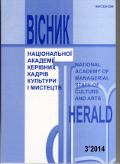THE FORMATION OF THE TOURIST IMAGE OF THE REGIONS IN THE CONTEXT OF THEMATIC TOURISM
DOI:
https://doi.org/10.32461/2226-3209.3.2014.138101Keywords:
travel image, attractions, thematic tourism, festivalAbstract
The article examines the role of the tourist image of the regions, in particular, on the example of the popular attractions in foreign countries. The problem of image formation and development of tourism is included in the focus of interest of many foreign and domestic scholars. Research on the theory of the formation of the international image of the work is devoted D. Aaker, S. Anholt, C. Balding, L.Brauna, Kotler, A. Romanov, I.Rozhkova, G. Zayachkovskoyi and others. Their work is a theoretical justification of the need to create and maintain the image of the states to promote the attractiveness of the country's prestige and so on. However, no single theoretical approach to the interpretation of the tourism image of the country.
The image of the country as defined by the UNWTO – a set of emotional and rational concepts arising from a comparison of all the features of the country experience and firsthand that influence the creation of a specific image. As noted by John F. Jones, the image is a set of associations and received information associated with a particular place.
These definitions focus is on emotional characteristics, but does not take into account the principles and laws of its
formation. The most comprehensive treatment of the international image of the country suggested A. Starostin, "an
image that appears in the subjects of brand perception at the level of the country's consumer perception, the perception of the level of businesses, the level of perception by the public authorities and perception at the level of supranational institutions as a result of awareness its core competencies, formed under the influence of market environment factors, and shapes their attitude to the country as negative, neutral or positive ".
Tourism image of the country – a set of symbolically expressed emotional and rational ideas about identity and
specificity of the country, formed in the minds of actual and potential tourists. This association, which arises in the mind when considering a product tour of the country concerned as direction of travel, leisure and recreation.
Coach image is based primarily on a territorial identity, which, on the one hand, involves formal characteristics
of the territory – a set of visual, verbal and other signs by which people identify territory. On the other hand, territorial identity also includes a set of characteristic features and resources of the territory, namely: 1) natural, demographic, historical, social and cultural characteristics and resources; 2) the economic characteristics and resources; 3) legal and organizational features information and resources.
Among the traditional forms of tourism (cultural and educational, event, festival, business) occupies a special place
tourism theme. Popular attractions are the thematic tourism holidays, carnivals, festivals, theatrical spectacle and more.
If we look at the geography of festival tourism, it should be noted that the largest and most powerful tourist flows
supplying European and American macro-regions, these same regions and tend biggest event tourism flows. Inaddition, most offer tours to a variety of sporting, cultural and national events in the most powerful information database of the world – the Internet – is also represented mainly European countries. According to the most popular topics are considered travel to international sports events and festivals.
Therefore, a regional tourist image in the international tourism scene takes place on a regular basis, however conducting various events of international scope gives countries a great chance to express their own world of travel
opportunities. Civilized, well established tourist sphere of the country is one of the fundamental factors optimizing
international image.
Downloads
Published
Issue
Section
License
Authors who publish with this journal agree to the following terms:
1. Authors retain copyright and grant the journal right of first publication with the work simultaneously licensed under a Creative Commons Attribution License that allows others to share the work with an acknowledgement of the work's authorship and initial publication in this journal.
2. Authors are able to enter into separate, additional contractual arrangements for the non-exclusive distribution of the journal's published version of the work (e.g., post it to an institutional repository or publish it in a book), with an acknowledgement of its initial publication in this journal.
3. Authors are permitted and encouraged to post their work online (e.g., in institutional repositories or on their website) prior to and during the submission process, as it can lead to productive exchanges, as well as earlier and greater citation of published work (See The Effect of Open Access).


